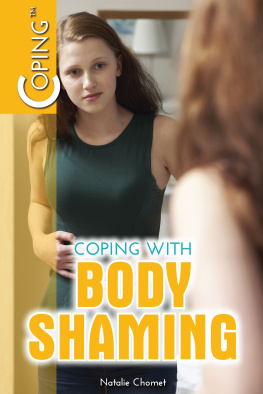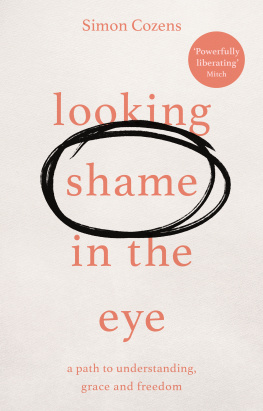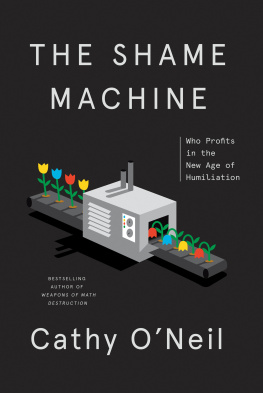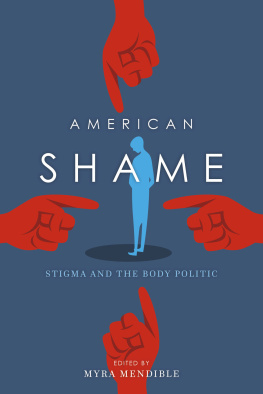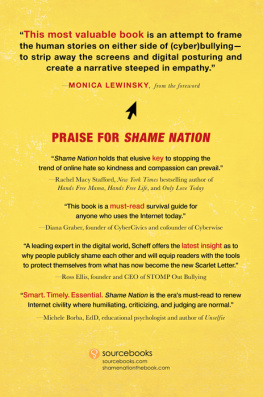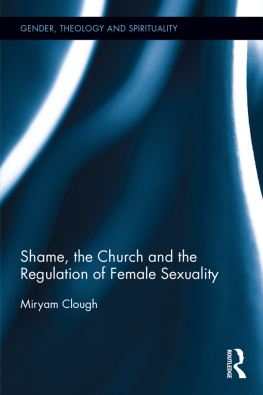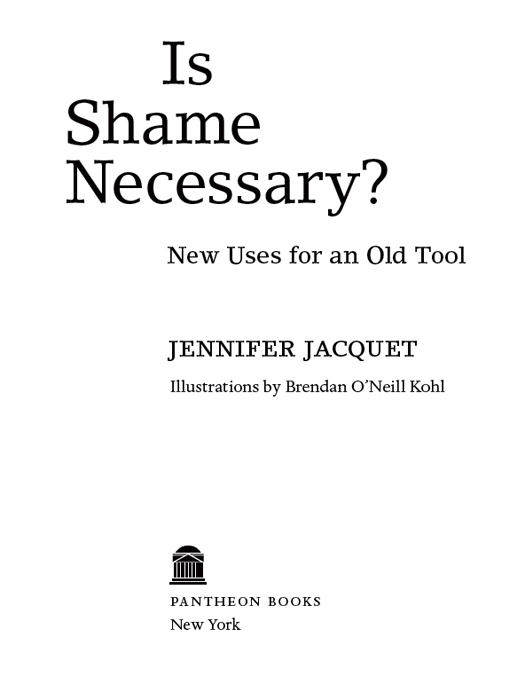Copyright 2015 by Jennifer Jacquet
All rights reserved. Published in the United States by Pantheon Books, a division of Random House LLC, New York, and in Canada by Random House of Canada Limited, Toronto, Penguin Random House companies.
Pantheon Books and colophon are registered trademarks of Random House LLC.
Library of Congress Cataloging-in-Publication Data
Jacquet, Jennifer.
Is shame necessary? : new uses for an old tool / Jennifer Jacquet.
pages cm
ISBN 978-0-307-90757-8 (hardcover : alk. paper).
ISBN 978-0-307-90758-5 (eBook).
1. Shame. 2. Guilt. 3. Human behavior. I. Title.
BF 575.S45J335 2014 302.35dc23 2014020331
www.pantheonbooks.com
Illustrations by Brendan ONeill Kohl
Jacket image: Vetta/Getty Images
Jacket design by Janet Hanson
v3.1
Shame. The feeling that will save mankind.
Screenplay for Andrei Tarkovskys Solaris (1972)
Shame is for sissies.
BARON EDWARD VON KLOBERG III , American lobbyist (19422005)
Contents
1
Shame Explained
[A mans] moral conscience is the curse he had to accept from the gods in order to gain from them the right to dream.
WILLIAM FAULKNER , interview in The Paris Review (1958)
In 1987, thirty-year-old Sam LaBudde walked into the offices of the Earth Island Institute, in San Francisco, looking for a job fighting rainforest destruction. He walked out headed for Mexico, planning to become a spy. In Earth Islands lobby, LaBudde read an article about how the tuna industry was killing millions of dolphins in purse seineslarge nets that encircle a school of tuna and are then drawn tight to catch everything in their purse, including dolphins, which then drown or are crushed in the gear that pulls in the net. The article was powerful, but there were no visuals. Instead of saving the rainforest, LaBudde convinced Earth Island to send him a video camera (this was the 1980s, before camcorders were common) and he set out to find a job on a tuna boat, as a ruse to collect footage of the dolphin slaughter.
LaBudde succeeded in becoming a deckhand and later a cook on board a Panamanian fishing boat operating out of Ensenada, Mexico. At great personal danger, he filmed several tapes of dead and dying dolphins caught in the tuna-fishing gear. Earth Island used the footage to launch a media campaign on national and local U.S. television. It was written up in newspapers and magazines, including a three-part series by Kenneth Brower in The Atlantic Monthly. The campaign was based on shaming, which involved exposing the transgressors to the American public. The target of the shaming was the tuna industry, specifically the three largest tuna companies: StarKist, Bumble Bee, and Chicken of the Sea.
Around this time, I convinced my mom to buy me a book titled 50 Simple Things Kids Can Do to Save the Earth (1990), and on the books advice I wrote a letter of inquiry to the Earth Island Institute. Weeks later, I found a response from the same group LaBudde had visited in San Francisco in my mailbox on our cul-de-sac in Ohio. The envelope included a haunting black-and-white photograph LaBudde had taken of a dolphin hoisted and dead on a tuna vessel. The campaign materials Earth Island sent me had shamed the tuna industry, but for me they incited guilt. Regardless of what anyone else thought, my conscience told me that what was happening to dolphins was wrong (never mind what was happening to tuna). Guilt is a feeling whose audience and instigator is oneself, and its discomfort leads to self-regulation. Looking at that image was my first time feeling miserable for a creature I had never metseen only in the pages of wildlife magazinesand my first time, but not last, feeling guilty for something I had eaten.
I needed to do something. At nine years old, I had already learned what the 1980s taught as the new rite of passage: to alleviate my guilt as a consumer. I insisted that our family stop buying canned tuna, and I wasnt alone. The evidence of mangled dolphins saddened and outraged people around the world and incited a large-scale tuna boycott by households and, later, a change of protocol by the major tuna companies. In an interview at that time, Anthony OReilly, former CEO of Heinz (which owned StarKist), said, I think it would be a poor CEO that was not attentive to his customers. And because of the affection that children have for Flipper and because of the gross scenes that were shown in the LaBudde film, there was a growing barrage of criticismwell orchestratedwhich I think served to convey a growing sentiment among schoolchildren that the previous fishing methods were no longer acceptable.
Those schoolchildren and their parents were among the relieved shoppers when the dolphin safe eco-label was introduced. We all felt better and resumed eating tuna. I didnt think about the tuna problem or the dolphin-safe label again for more than a decade. When I finally did, it was because I realized we had been duped.
The dolphin-safe logo, introduced in 1990, was but one of the newly introduced market tools to save the world. That same year, the U.S. government established organic food legislation (although the first organic food certification was founded in Santa Cruz, California, in 1973). The Forest Stewardship Council, an international scheme, was formed in 1993, after years of discussions about how to certify forestry practices as sustainable. The Marine Stewardship Council, the main program to certify sustainable fisheries, started up in 1997, the same year that Fairtrade International was created. Many more labels followed.
Until this push for certification, the goal of shaming campaigns and boycotts had been to fundamentally change entire companies or industries. Activists like Cesar Chavez, behind the strike and boycott of table grapes in the 1960s, would not have ended their efforts with a label on grapes that read, PICKED BY FARMWORKERS WHO EARNED A MINIMUM WAGE . The aim was not to satisfy the concerns of a few consumers, but to (among other things) change federal rules for the minimum wage and workplace safety for all farmworkers. The exposure of poor sanitation in meatpacking factories in the early twentieth century was not intended to produce a label that would allow concerned consumers to purchase hygienic meatthe goal was to raise sanitary standards everywhere.
But by the 1980s, the notion of directly changing supply was being displaced by the idea of changing demand. At first glance, this strategy seems reasonable, particularly in a laissez-faire economy: if demand changes, supply should respond. The two are balanced on opposite sides of the ledger, as I was often reminded during my six years studying economics. The new plan of engagement, which even environmentalists supported because the Reagan era had ushered in a political climate that had become more and more hostile toward regulation, saw the pocketbook as the most powerful avenue of persuasion. This strategy allowed consumers to retain their freedom to choose (the battle cry of libertarian economist and free-market popularizer Milton Friedman) and suggested that guilt-ridden shoppers could avoid their uneasy feelings by simply changing their buying habits.
As the focus shifted from supply to demand, shame on the part of corporations began to be overshadowed by guilt on the part of consumersas the vehicle for solving social and environmental problems. Certification became more and more popular, and its rise quietly suggested that responsibility should fall more to the individual consumer rather than to political society. The notion of certification also disposed of shame and targeted guilt as the main form of engagement. Guilt could be used to motivate individuals in a way that it could not be used for entire industries or suppliers, but it could also be used


